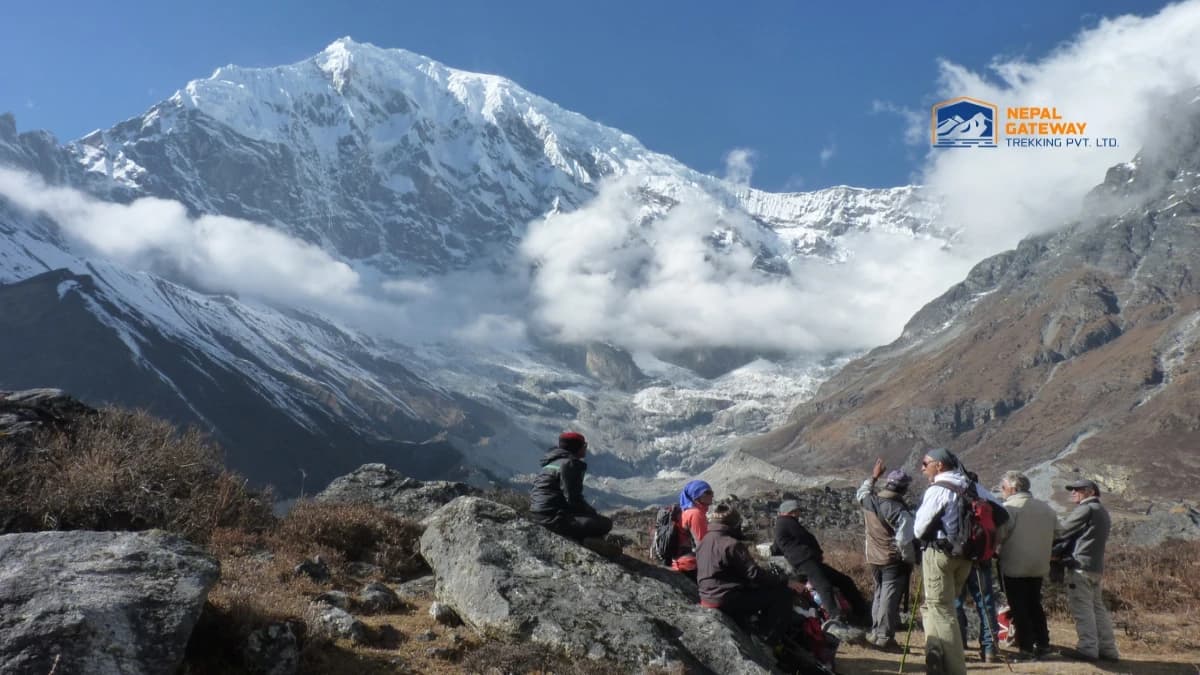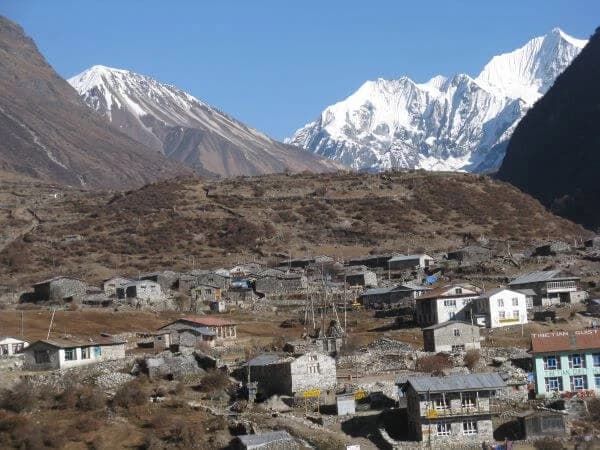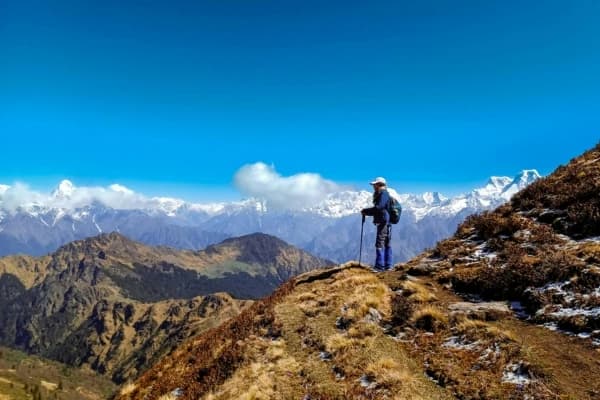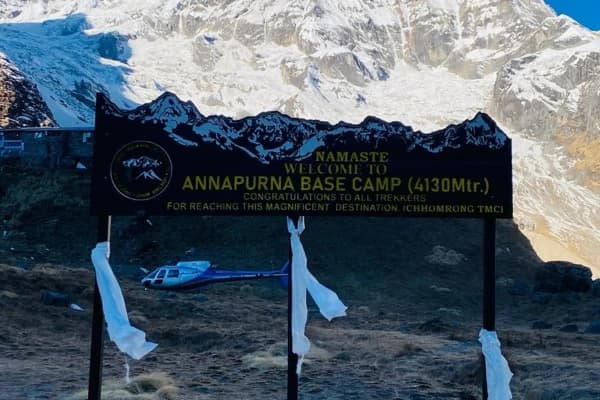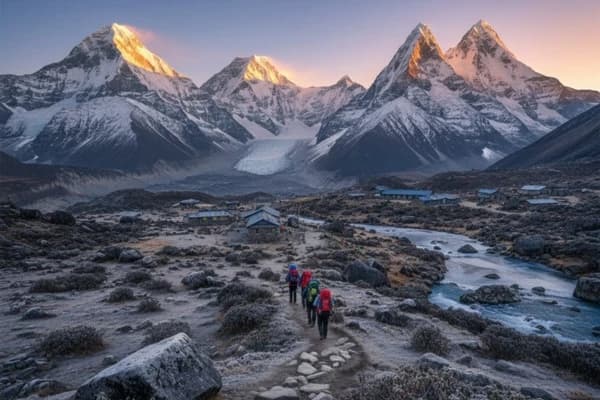The best time to trek Langtang is during Spring (March to May) and Autumn (September to November), when the weather is clear, temperatures are moderate, and the mountain views are stunning. These seasons offer the safest and most enjoyable trail conditions for trekkers.
Spring (March to May) is one of the best times to trek in the Langtang region. The weather is stable, skies are clear, and the trails are lined with blooming rhododendrons and vibrant forests. You’ll enjoy warm days, cool nights, and breathtaking views of snow-capped peaks throughout the journey.
Autumn (September to November) is another ideal time to visit Langtang. With post-monsoon clarity, the air is crisp and the mountain vistas are at their sharpest. Trails are dry, visibility is excellent, and temperatures are comfortable, making it perfect for both beginners and experienced trekkers.
You’re excited about trekking in the Langtang Valley, but you feel confused about when exactly to go. With so many seasons to choose from, it’s tough to decide the best time to plan your trip.
Picking the wrong time can turn your dream trek into a challenge. Imagine battling slippery trails and landslides during the monsoon or shivering through freezing nights in the harsh winter.
Or worse, you could face cloudy skies blocking the stunning mountain views you came for, or crowded paths making it hard to enjoy the peaceful nature. None of these sounds fun, right?
Don’t worry — this detailed guide is here to clear up all the confusion. We’ll walk you through the best time to trek Langtang, taking into account weather, trail conditions, crowd levels, and more. If you want colorful spring flowers, perfect autumn skies, or a quiet winter adventure, you’ll find the right season to suit your style.
We’ll even break down the Langtang Valley Trek weather by month and share important tips to make your trek safe and comfortable. With the right knowledge, you can match your expectations with the ideal season and truly enjoy every step of the journey.
Key Attractions
- Marvel at jaw-dropping views of Langtang Lirung and Dorje Lakpa—perfect for your adventure photos!
- Dive into the rich culture of Tamang villages with the Langtang Tamang Heritage Trek and meet warm-hearted locals.
- Spot elusive red pandas and other wildlife deep in Langtang National Park—nature at its finest!
- Taste fresh, handmade cheese straight from the famous Kyanjin Gompa cheese factory.
- Enjoy peaceful, uncrowded trails away from the busy Everest and Annapurna routes.
- Wander through vibrant rhododendron forests that explode with color in spring.
- Soak your tired muscles in natural hot springs—pure bliss after a long day trekking.
When is the Best Time for the Langtang Trek?

So, when exactly is the best time to trek Langtang? Honestly, you can’t go wrong with the Langtang Trek in spring and autumn. The skies are clear, the temperatures are just right, and the trails are in great shape.
Spring and autumn bring blooming rhododendrons, cultural festivals, and those stunning Himalayan views we all dream of. If you're into great photos, spotting wildlife, and cozy teahouse vibes, this is the best time to trek in Langtang.
Winter and monsoon treks are also possible but require extra planning and flexibility, especially regarding trail conditions and gear. For adventurous trekkers, these off-seasons can still be deeply rewarding with fewer crowds and peaceful surroundings.
If you are trek lover, you can explore the best selling trips for your next destination.
Langtang Trek in Spring (March to May)
Spring in Langtang is magical. Wildflowers bloom, rhododendrons light up the forest, and the weather stays comfortably cool. This vibrant season is considered the best time to trek Langtang, with trails alive with color and energy.
Good Points
- Stunning rhododendron forests in full bloom
- Great visibility of snow-capped peaks
- Pleasant trail conditions with less mud
- Moderate temperatures are ideal for hiking
- Abundant wildlife sightings
- Peaceful villages with welcoming locals
But..
- Crowds start building up by late April
- Slight haze in late May due to pre-monsoon moisture
- Early spring (March) can still be chilly at higher altitudes
- Occasional wind gusts in exposed areas
- Risk of sudden weather changes in late spring
- Possible pollen allergies for sensitive trekkers
Love flowers and mountain views? Nepal Gateway Trekking offers custom spring treks with flower-watching tours!
Langtang Trek in Autumn (September to November)
If you ask seasoned trekkers about the best season for the Langtang trek, most will say autumn—and for good reason. After the rains, the skies open up crystal clear, and the mountains look sharper than ever. It’s truly the Best Time to Trek Langtang if you're chasing postcard-perfect views, pleasant weather, and vibrant local festivals along the trail.
Good Points
- Comfortable temperatures
- Festivals like Dashain and Tihar along the route
- Stable weather with minimal rain
- Vibrant cultural experiences with local celebrations
- Longer daylight hours for trekking
- Abundant wildlife sightings in the region
But..
- Lodges may be fully booked if you don't plan early
- Higher prices for accommodation and services
- Some trails can feel crowded and less peaceful
- Increased traffic on roads leading to trailheads
- Limited flexibility in itinerary due to high demand
- Pressure on local resources and the environment
Planning a Langtang trek? Discover the best time to visit Nepal and make the most of your Langtang trekking experience with ideal weather and views.
Is Langtang Trek Doable in the Off-Season?
Yes, the Langtang trek is possible year-round, but the Best Time to Trek Langtang is during spring and autumn. Langtang Trek in winter and monsoon is doable for those seeking solitude and off-season discounts, but it demands proper preparation.
Trekking in Langtang during the winter and monsoon seasons is doable for those seeking solitude and off-season discounts. However, it requires proper preparation and experience to handle the challenges of these seasons.
In winter, expect cold nights and possibly snow-covered trails. During the monsoon, the trails can be muddy and prone to leeches. With the right gear and travel guidance, even the off-season can turn into an unforgettable adventure.
Langtang Trek in Monsoon (June to August)
In Langtang, the monsoon entirely changes the scenery into a verdant, colorful wonderland. With waterfalls tumbling down the hillsides, the woodlands spring to life, and the whole valley is revitalized.
However, this beauty comes with its own challenges—heavy rains can lead to slippery trails, landslides, and poor visibility, making trekking more difficult and sometimes dangerous.
Even though the monsoon season delivers a serene, less crowded experience among the vivid hues of nature, it necessitates careful preparation, appropriate equipment, and a flexible schedule to deal with the weather's unpredictable nature.
Plus Points
- Greenest landscapes with vibrant flora
- Fewer tourists, offering a peaceful trek
- Discounted rates for guides and accommodations
- Quiet trails for a more immersive nature experience
- Unique monsoon-season waterfalls and rivers in full flow
- Cooler temperatures that some trekkers prefer
Risks
- Increased chance of landslides and slippery trails
- Poor visibility due to heavy clouds and rain
- Risk of leeches on lower forested trails
- Muddy paths that can slow your progress
- Limited availability of some teahouses due to the low season
- Possible flight delays or road blockages from bad weather
Monsoon trek lover? Nepal Gateway Trekking provides customized trips and local guides for those trips who know how to keep you safe and dry.
Langtang Trek in Winter (December to February)
Winter in Langtang is cold but incredibly rewarding for solitude seekers. The crisp air and snow-covered landscapes create a magical trekking experience unlike any other. Wildlife is quieter, and the trails are far less crowded, giving you a true sense of wilderness and calm.
If you don’t mind freezing nights and quiet trails, this season might just be the Best Time to trek Langtang for peace, snowy landscapes, and uninterrupted mountain views. Just make sure you're well-prepared with the right gear and a reliable guide.
Plus Points
- Fewer trekkers, more peace
- Clear skies and snowy views
- Budget-friendly travel
- Crisp, fresh mountain air
- Beautiful frost-covered landscapes
- More availability in lodges and transport
Risks
- Very cold at night
- Some teahouses may be closed
- Icy and slippery trails
- Limited daylight hours for trekking
- Risk of altitude sickness due to cold
- Fewer local amenities and services are available
Want a winter wonderland? Nepal Gateway Trekking has cold-weather gear rental and expert equipment checklist.
Month-by-Month Breakdown Overview
Understanding the weather month by month can really make or break your Langtang trekking experience. Knowing what to expect in terms of temperature and trail conditions each month helps you plan better. From chilly winter days to vibrant spring blooms and crisp autumn skies, each month offers something unique. Being prepared for these changes means a safer and more enjoyable trek overall.
If you want to pick the Best Time to Trek Langtang, this detailed breakdown will guide you through the ideal months so you can enjoy the best weather and trail conditions for your adventure.
|
|
|
|
|
|
|
|
|
|
|
|
|
|
|
|
|
|
|
|
|
|
|
|
|
|
|
|
|
|
|
|
|
|
|
|
|
|
|
|
|
|
|
|
|
|
|
|
|
|
|
|
|
|
|
|
|
|
|
|
Not sure which month suits you? Nepal Gateway Trekking offers personalized recommendations. Get in touch!
Trek Timing Secrets Only Experienced Hikers Know

Choosing the best time to trek Langtang isn’t just about sunny days or mountain views. Several practical and personal factors can completely change your experience. Here’s a breakdown of what trekkers should keep in mind before locking in dates:
Budget
If you’re wondering about the best time to trek Langtang on a budget, the off-season months—monsoon and winter—offer cheaper rates on accommodation, guides, and transport. During these times, many lodges and trekking agencies provide discounts to attract visitors despite the tougher conditions. However, keep in mind that the lower prices come with challenges like colder weather and muddy trails, so proper preparation is key.
However, you’ll be trading those savings for higher risks like slippery trails and fewer amenities along the way. Spring and autumn might cost a bit more, but they provide safer trails, stunning scenery, and the full teahouse experience that makes the trek truly enjoyable.
Weather Condition
The weather plays a huge role. Spring (March–May) is vibrant with blooming flowers and moderate temperatures, while autumn (September–November) offers crisp air and clear skies. Winter brings stunning snow views but also freezing nights. Monsoon makes trails muddy and less predictable.
Flight or Road Transport
Langtang starts with a road trip to Syabrubesi. During monsoon, roads can be blocked or damaged by landslides, so spring and autumn are safer bets for smooth travel.
Trail Condition
Dry and stable trails in spring and autumn make trekking easier. In winter, snow can block paths; in monsoon, mud and leeches may slow you down.
Crowd
Autumn is the busiest season, followed by spring. If you love quiet trails and peaceful nature, consider trekking in winter or early monsoon.
Personal Preferences
Festivals like Dashain and Tihar in autumn can add cultural charm. Spring is perfect for nature lovers. Prefer solitude? Go in the off-season. Your priorities and trekking style will determine the best time for you. When selecting your timing, think about whether you prefer quiet paths or raucous community festivals. The key to making your Langtang journey genuinely unforgettable is choosing a season that aligns with your interests.
Still unsure? Talk to Nepal Gateway Trekking for tailored advice.
Questions About the Best Time to Trek Langtang
What is the best month to trek in Langtang?
October and April are the best months to visit. These months offer clear skies, comfortable temperatures, and great trail conditions for an enjoyable trek.
Is the Langtang trek safe during the monsoon?
It can be risky due to landslides and slippery trails. If you choose to trek during monsoon, it’s best to go with a professional guide and be prepared for sudden weather changes.
Can I do the Langtang trek in winter?
Yes, but it’s very cold, especially at night. Proper gear, warm clothing, and careful planning are essential to staying safe and comfortable.
Are permits required for Langtang?
Yes. You need a Langtang National Park Entry permit and a TIMS (Trekkers’ Information Management System) card. These help protect the environment and ensure your safety.
Is Langtang good for beginners?
Yes! It’s considered a moderate trek, making it great for first-time trekkers. The trail is well-marked, and there are plenty of teahouses along the way.
How long is the Langtang Valley Trek?
Typically, it takes 7 to 10 days, depending on your pace. This allows time to acclimatize and enjoy the stunning scenery without rushing.
Are lodges open year-round?
Most lodges stay open throughout the year, but some may close during the harshest winter months. It’s good to check ahead and book in advance during peak seasons.
What kind of food is available?
Common meals include Dal Bhat (lentil rice), pasta, momos (dumplings), soup, and plenty of tea. Most teahouses cater well to trekkers’ dietary needs.
How do I reach the starting point?
You’ll drive from Kathmandu to Syabrubesi, which takes about 7–8 hours. The road is scenic but can be bumpy, so prepare accordingly.
Why choose Nepal Gateway Trekking?
We’re local, experienced, and safety-focused. Our team is passionate about making your Langtang trek unforgettable with personalized service and expert guidance.
